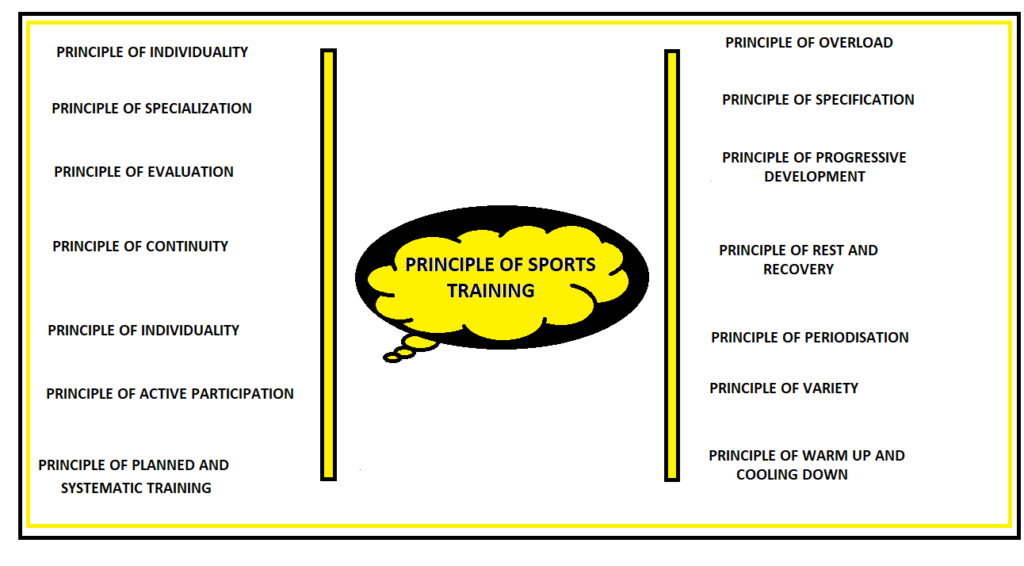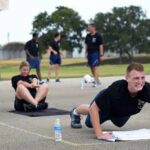The principles of sports training are designed to guide the coach, teacher, or player to control sports and sports training. Principles of sports training can be general and special. General Training Principles is valid for general sports training.
Principles are not valid in a particular state or action. The principle is mainly for the whole group. This principle can sometimes be changed for a particular person. According to the nature of the rule, the principle can be changed further. It is human nature that he makes some important education term for achieving his goal, which should make the path to his goal easy and simple.
13 PRINCIPLES OF SPORTS TRAINING:
- Principle of overload
- Principle of specification
- Principle of Progressive Development
- Principal Of Rest And Recovery
- Principle of periodisation
- Principle of active participation
- Principle of Variety
- Principle of Individuality
- Principle of specialization
- Principle of Planned And Systematic Training
- Principle of Evaluation
- Principle of continuity
- Principle of warm-up and cool down


PRINCIPLE OF OVERLOAD
Overload means that training is brought along with progress in fitness which is a challenge to the player’s current state of fitness. Improvement in a person’s abilities is sports training, an advanced principle of training. Furiousness causes the player to become fatigued as the fury ends.
READ MORE ABOUT- https://www.sportzyogi.com/major-difference-between-yoga-and-exercise/
PRINCIPLE OF SPECIFICATION
Training should be specific according to the deprivation effect. According to the principle of uniqueness, the intensity of training determines the effectiveness of training. The amount of training should be specified according to the intensity and rehabilitation of the training. The training program should be specially designed so that it can cater to specific parts of a particular sport or activity. According to the principle of uniqueness, the intensity of training determines the effectiveness of training.
PRINCIPLE OF EVALUATION
In this, coaches do evaluations to increase their player performance. For example, the height, weight, muscle capacity, and all the skill tests of the player are tested. This shows how much he has been able to improve in his performance in the training given by the coach, whether the performance level of each training program has reached a high level to win any competition. Evaluation of training program is very important for that, without the training program of evaluation cannot be completed. Only after doing the evaluation test, helps to improve performance
PRINCIPLE OF PROGRESSIVE DEVELOPMENT
Progressive development means the development of normal body movement techniques and wellness which are the initial goals of the training year. If more balanced normal development occurs in the initial state, then in the later stages significant levels of performance can be achieved. This principle should be given more attention in training the game learners from the beginning. Because this is the first stage of planned thinking of sports training
PRINCIPLE OF REST AND RECOVERY
Rest and recovery is a key factor in sports training to increase the performance of the player. If the player does not get enough rest, then his / her muscle ability to re-work slowly starts to decrease which has a direct effect on his / her performance. It should be kept in mind that if he has done any vigorous activity, then the player should also be given rest accordingly so that he gets the recovery time.
READ MORE ABOUT- What is pranayam?
PRINCIPLE OF PERIODISATION
Sports training programs are made through a series or cycle of fixed duration. It usually has three-time divisions –
Macro Cycle– This is a long cycle that can be of 4 to 12 months or more duration.
Meso Cycle – is intermediate or medium-term and can be weekly.
Micro Cycle– This cycle is of short duration, it can be from 2 to 10 days.
PRINCIPLE OF ACTIVE PARTICIPATION
This principle implies that for good results of sports training, the player should take an active part in this process as he wishes. This is a process between the sports training players and the coach. The player must be well aware of the purpose of their training program. There should be a regular evaluation of each program. The player must follow the instructor’s instructions.
PRINCIPLE OF VARIETY
To overcome the problem of inactivity and stability in sports training, different types of teaching methods and tools should be used.
PRINCIPLE OF INDIVIDUALITY
Age and gender differences affect the training program. Training methods or systems vary for each player. According to this principle, the training program should be designed according to the personal qualifications, needs, and abilities of the player. No other player should be copied. No player can be the same in any group or team, there is some difference in all, so the coach should have the knowledge to try to equalize the potential of each. With this, the player’s sports performance can be improved significantly.
The following factors affect the performance of some players –
Biological age – The bones of a child 15 to 16 years grow from the last part like the epiphyseal plate in the elbow joint. The actual age or biological age is from birth to 27 years. Biological age affects sports performance.
Sex- In some games, sex has a significant effect; its main role is that in wrestling, women are weaker than mail but vice versa in gymnastics.
PRINCIPLE OF CONTINUITY
This principle means continuity of training. If sports training is not made challenging then the level of fitness becomes stable. In the absence of continuity, the effect of training is eliminated and the level of adaptation or fitness falls due to extreme intensity in practice. If sports training is discontinued, then the level of fitness starts decreasing gradually until it reaches the level required for daily ordinary activities.
PRINCIPLE OF PLANNED AND SYSTEMATIC TRAINING
This is the main rule of principle; a training program must be pre-planned. Each phase and stage should be well planned. If the coach and the trainer have not prepared the training program in advance, then they cannot proceed in a systematic way. Hence the result will not come. Rather, you should be prepared for the training program in advance, only then you can give variegated kind of training systematically, so you can achieve your goal. Strength training should be given first and then endurance and speed training.
PRINCIPLE OF SPECIALIZATION
The training programs that develop the right techniques and abilities for a particular activity or sport are called the principle of specialization. A runner needs elements of speed and endurance, so he must develop a technique of running in which an excellent method of running for the distance to be adopted.
PRINCIPLE OF INCREASING LOAD
By giving more loads to a player, his physical activity does not increase but increases by giving more repetitions. A player must move from low load to high load. In this way, we can get the best performance out of the player by giving training load to the player systematically.
Two Types of Method Used Increasing Load Principle :
Linear method – This method is for short time, if we have less time, then use this method, in this method the load is directly increased and made every day.
Step by step method – In this method, the performance of the player increases step by step, after completion of the competition at least 1 to 2 weeks recovery or after rest, the load can be increased with step by step method. This method is better than the linear method.
PRINCIPLE OF WARM UP AND COOL DOWN
Warming up before any activity and cooling down after activity is a very important principle of sports training, training without warm-up increases the chances of injury in the body, which can directly affect the player both mentally and physically. In the same way, it is equally important to cool down after training, so that the tiredness in our muscles can be relieved by stretching so that the incoming training session does not cause any sort of strain or stretch.





